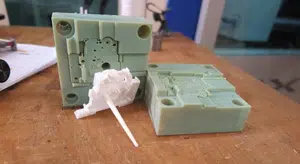With efficiency enhancement central to its value proposition and, indeed, the ethos of the company itself, Schneider Electric was keen to explore ways of streamlining certain manufacturing processes to achieve both short- and long-term efficiency goals.
To help meet these objectives, the company has incorporated Stratasys 3D printing technology across its manufacturing operations in Grenoble, France, having originally used it for several years for prototyping new solutions.
Schneider Electric now uses a combination of Stratasys PolyJet and FDM based 3D Printing solutions for product development, prototypes and industrialization. This comprises multiple applications, including injection molding and assembly-line tooling, the design and production of which is managed via the company’s internal model shop, Openlab. This extensive deployment of 3D printing technology also complements the company’s vision of creating the Factory of the Future.
Multi-national Schneider Electric is planning its Factory of the Future with Stratasys 3D Printing Tweet thisThe combination of dramatic financial savings and a greatly enhanced workflow achievable from incorporating Stratasys 3D printing into the process has contributed to the plant’s overall manufacturing efficiencies and reduced the time-to-market in key areas.
“This year, Schneider will launch around 400 new solutions, which is more than one a day,” says Sylvain Gire, Vice-President, GSC Transformation-Industrialization at Schneider Electric. “Therefore, it is critical that we adopt technologies that help us reduce time-to-market.”
It is critical that we adopt technologies such as 3D printing to reduce time-to-market - Sylvain Gire,… Tweet this
One area in particular that underscores the efficiency benefits delivered by the company’s Stratasys 3D printing technology is the production of injection mold inserts used to print functional parts.
The company slashed the cost of producing injection mold inserts used for prototyping designs by 90%, from 1,000 euros when manufacturing the same item in aluminum to just 100 euros with 3D printing.
“We’re witnessing an astronomical cost-saving from 3D printing injection molds, but we’ve also drastically cut the time taken to produce them, so we’re looking at a win-win every time,” explains Gire.
“Manufacturing the prototype molds in aluminum necessitates – in some cases – a lead time of as much as two months, but with Stratasys’ 3D printing solutions, the whole process is completed within a week,” he adds. “That’s a roughly 90% time savings, which would be unfathomable with any other technology.”
Efficient design and engineering of assembly-line tooling
These benefits also extend to Schneider Electric’s mechanical design and engineering department, which is tasked with the production of assembly, control and adjustment tools for its diverse product range. Here, the company utilizes a mix of both FDM-based materials (including thermoplastic polycarbonates) and PolyJet materials (such as the highly accurate Digital ABS) to produce prototype jigs and fixtures to validate the ergonomics and functionality of final assembly tools. Such tools span a range of items, including welding tool connectors, electromagnetic displacement controls and printed circuit board assembly connection tools.
Schneider Electric uses Stratasys FDM & PolyJet 3D printing for prototype jigs & fixtures to test… Tweet thisUsing 3D printing to design and engineer assembly-line tools for validation enables the company to save time in the production of the final tools. Harnessing Stratasys’ Connex multi-material 3D printing technology, department manager, Yann Sittarame and his team can produce new manufacturing tool prototypes in just one week. In the past, it would have taken at least three weeks to produce the same tools using conventional CNC machining, which amounts to a massive time-saving of around 70%.
“This technology has changed the way we work and changes the way we think about doing things in the future,” explains Sittarame. “Looking ahead, we plan to 3D print the final tools, which is perfectly achievable given the accuracy and durability of our 3D printing process.

